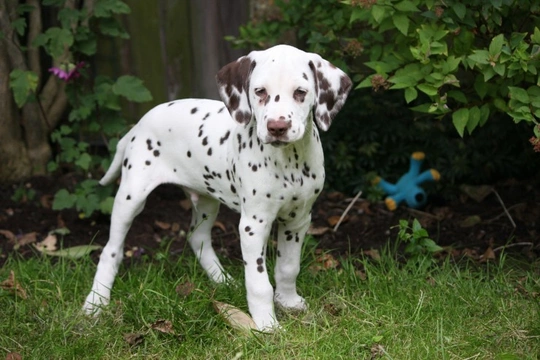
Panosteitis in the Dalmatian dog breed
Dalmatians are one of the most distinctive looking and handsome dog breeds of them all, thanks to their smart spotted coats and of course, their appearances in films such as 101 Dalmatians and the various sequels and re-makes that have been released over the years.
Whilst many dog lovers love the Dalmatian appearance and temperament, this is certainly one dog breed that can be quite a handful to own, and they are fairly high maintenance dogs that have often complex care needs.
Dalmatians are very high energy dogs that are always on the go and looking for things to do and play with, and they are also very mischievous and inquisitive, which keeps their owners on their toes. Dogs of the breed can also be challenging to train and manage on a day to day basis too, but Dalmatians are an undeniably rewarding pet for owners that know what they are getting in to and are up to the task.
Something else to bear in mind if you have your heart set on owning a gorgeous spotty Dalmatian puppy is that the breed’s overall health tends to be below the average across all dog breeds, and there is quite a long list of congenital and hereditary health conditions that can afflict dogs of the breed.
One such condition is called panosteitis, which is also sometimes referred to as puppy growing pains – and this is something you should make yourself aware of if you intend to buy or adopt a Dalmatian puppy.
In this article we will look at panosteitis in the Dalmatian dog breed in more detail, examining why it occurs, how it presents, and what can be done about it. Read on to learn more about panosteitis and Dalmatians.
What is panosteitis?
Panosteitis (sometimes referred to as puppy growing pains) is a condition that can affect puppies during their growth stages, and it is an inflammatory condition that affects the dog’s long leg bones, and which can affect all four legs, front and hind pairs, or just one leg at a time.
Panosteitis of the front legs is the most common form of the condition, although this can be very variable.
When a puppy with panosteitis grows and develops, the usual process of bone growth and renewal don’t follow the normal development pattern, which can cause thickening of the long bones of the legs and associated pain.
What sort of Dalmatians might suffer from panosteitis?
Panosteitis is not an illness that can be caught or contracted, but is something that affected dogs have a genetic predisposition to, which makes it more prevalent in some breeds and types of dogs than others, with the Dalmatian being one of them.
Whilst by no means all Dalmatian puppies will suffer from panosteitis, dogs with a parent or other close relative who had the condition are more likely to develop panosteitis themselves.
Panosteitis is a condition that affects puppies and juvenile dogs, and which generally flares up for the first time in dogs aged between around 5-15 months of age. However, this is only a broad guide – some pups with panosteitis will develop symptoms from just a few weeks old, whilst some won’t be affected until they are over 18 months of age.
Both males and females are equally likely to be affected with the condition, and affected dogs will tend to have several bouts of panosteitis flare-ups during their first couple of years of life. However, after the age of around two, the flare-ups are likely to stop.
What are the symptoms of panosteitis in Dalmatians?
The symptoms that any Dalmatian displays can be variable in terms of the leg or legs that are affected by panosteitis, how severe it is, and how often flare-ups occur. The onset of a bout of panosteitis is often quite rapid, and the legs that it affects can vary from attack to attack too.
Some of the main symptoms of panosteitis in Dalmatian puppies include:
- A pronounced, sudden onset lameness for no good reason, which may affect anything from one leg to all four.
- Lameness that presents differently at different times, such as by moving from leg to leg in between periods of the dog appearing fine.
- A higher than normal temperature.
- Exercise intolerance and lethargy, or a reluctance to play and run around.
- A poor appetite or refusal to eat.
- Muscle wastage over time.
- Swelling of the affected limbs, which may also be hot to the touch.
Can anything be done about Dalmatian panosteitis?
All owners of Dalmatians under the age of two are advised to learn the symptoms of panosteitis and keep an eye out for any of them within their own dog. If you spot something amiss, contact your vet for an appointment so that they can get to the bottom of it.
Panosteitis in Dalmatians can’t be prevented or cured, but the good news is that it can be managed successfully until your dog outgrows the condition by the age of around two, if not sooner.
Panosteitis is usually painful and uncomfortable for affected dogs, and so your vet will almost certainly prescribe pain medications and potentially, anti-inflammatories to help your dog to deal with flare-ups.
Keeping your dog comfortable and avoiding strenuous exercise during flare-ups is important too, as is keeping your dog at a healthy weight.



